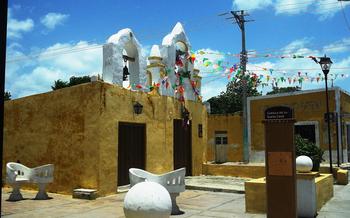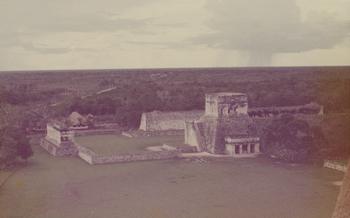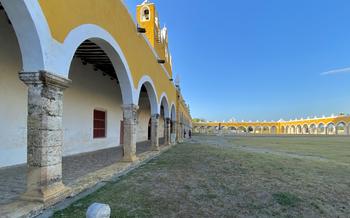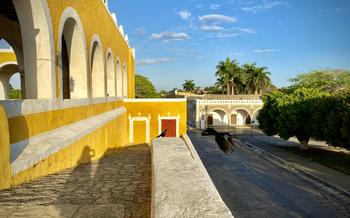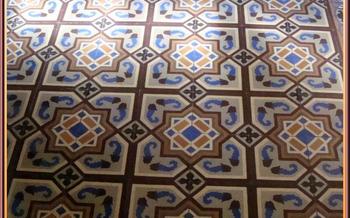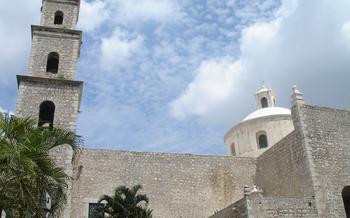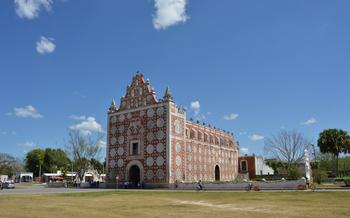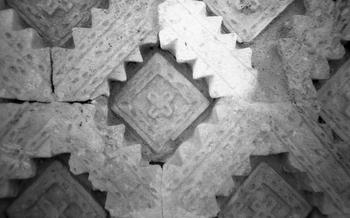
Templo de las Monjas (Nearby city)
- Archaeological Significance of the Site
- Unique Architectural Style
- The Convent's Function and Significance
- The Church's Interior and Altars:
- The Templo de las Monjas as a UNESCO World Heritage Site
- Tips for Visiting the Templo de las Monjas
- Nearby Attractions
- Shopping and Handicrafts
- Cultural Events and Festivals:
- Nightlife and Entertainment:
- Transportation and Getting Around:
- Insider Tip: Discovering Izamal's Hidden Gems
Archaeological Significance of the Site
Izamal, a city in Yucatán, Mexico, holds significant archaeological importance due to its rich Mayan history and Spanish colonial influence. The Templo de las Monjas, or the Convent of the Nuns, is a prime example of this unique blend of cultures. The site was once a thriving Mayan city, known as Itzamal, which served as a major religious and ceremonial center. The Mayans built impressive structures, including pyramids and temples, some of which can still be seen today. After the arrival of the Spanish in the 16th century, the city underwent a transformation, with many of the Mayan structures being repurposed or modified to suit the needs of the new colonial power.
Unique Architectural Style
The Templo de las Monjas stands out for its unique architectural style, which seamlessly blends Mayan and Spanish elements. The facade of the church exhibits a combination of Plateresque and Renaissance influences, showcasing intricate carvings and decorative elements. The interior of the church is equally impressive, featuring a vaulted ceiling adorned with beautiful frescoes and gold leaf embellishments. The use of limestone and stucco adds to the building's grandeur, creating a harmonious blend of indigenous and European architectural traditions. This unique style is a testament to the rich cultural heritage of Izamal and the skill of the artisans who constructed this architectural masterpiece.
The Convent's Function and Significance
The Templo de las Monjas was a significant religious and cultural institution during the Spanish colonial period. It served as a convent for Augustinian nuns, who played a crucial role in the spread of Christianity and the education of young women in the region. The nuns dedicated their lives to prayer, community service, and the preservation of religious traditions.
The convent also functioned as an educational center, offering classes in reading, writing, music, and domestic skills to young girls from prominent families. This institution provided an opportunity for women to gain knowledge and skills that would enable them to contribute to society.
As a religious center, the convent was a place of worship and pilgrimage for the local community. The nuns held daily masses, organized religious processions, and provided spiritual guidance to the faithful. The convent's influence extended beyond the walls of the complex, shaping the religious and cultural landscape of Izamal. It served as a symbol of faith and a source of comfort and support for the people of the region.
The Church's Interior and Altars:
The interior of the Templo de las Monjas captivates visitors with its stunning beauty and intricate details. The church's vaulted ceiling, adorned with vibrant frescoes, depicts scenes from the life of Christ and the Virgin Mary. The walls are adorned with elaborate carvings and gold leaf, creating a sense of grandeur and opulence. The main altar, a masterpiece of Baroque art, features intricate carvings depicting scenes from the Bible. The side altars, dedicated to various saints, are equally impressive, showcasing the skill and artistry of the craftsmen who created them. The stained glass windows, with their vibrant colors and intricate designs, bathe the interior in a warm, ethereal light, adding to the church's mystical atmosphere.
The Templo de las Monjas as a UNESCO World Heritage Site
The Templo de las Monjas was declared a UNESCO World Heritage Site in 1993, recognizing its outstanding universal value. This prestigious designation is bestowed upon sites that hold exceptional cultural or natural significance and are considered to be of importance to humanity as a whole.
Criteria for UNESCO World Heritage Designation: The Templo de las Monjas meets several criteria for UNESCO World Heritage designation:
-
Cultural Heritage: The convent is a unique and well-preserved example of the fusion of Mayan and Spanish architectural styles. Its distinct features, such as the vaulted ceilings, intricate carvings, and use of limestone and stucco, showcase the cultural exchange and blending that occurred during the colonial period.
-
Architectural Masterpiece: The convent's architectural design, combining pre-Hispanic and European elements, is a masterpiece of human creative genius. The harmonious integration of these diverse styles has resulted in a structure of remarkable beauty and historical significance.
-
Outstanding Universal Value: The Templo de las Monjas stands as an exceptional example of a colonial-era convent that played a vital role in the evangelization of the Maya. Its unique architectural style, historical significance, and cultural importance make it an outstanding site of universal value.
Importance of Safeguarding and Preserving the Site: The UNESCO World Heritage designation underscores the importance of safeguarding and preserving the Templo de las Monjas for future generations. This recognition highlights the need to protect the site from potential threats, such as urban development, natural disasters, and neglect. The designation also serves as a reminder of the site's cultural significance and the responsibility to ensure its ongoing preservation and accessibility.
Celebrating Cultural Heritage and Diversity: The Templo de las Monjas' inclusion on the UNESCO World Heritage list is a testament to the importance of cultural heritage and diversity. It is a celebration of the unique and invaluable contributions that different cultures have made to the world's architectural and historical legacy. The site's designation serves as a reminder of the importance of preserving and protecting our shared cultural heritage for the benefit of all humanity.
Tips for Visiting the Templo de las Monjas
To make the most of your visit to the Templo de las Monjas, consider the following tips:
-
Plan your visit during the dry season (November to April) to avoid heavy rains and enjoy pleasant weather. The site is typically less crowded during this time, allowing for a more tranquil experience.
-
Dress appropriately for the occasion, respecting the site's religious significance. Lightweight, modest clothing that covers your shoulders and knees is recommended.
-
Take advantage of guided tours offered by the site's knowledgeable guides. These tours provide insightful commentary on the history, architecture, and significance of the Templo de las Monjas, enhancing your understanding of the site.
-
If you have mobility concerns, inquire about accessibility options. The site strives to accommodate visitors with disabilities, providing wheelchair ramps and accessible restrooms.
Nearby Attractions
In addition to the Templo de las Monjas, Izamal offers a variety of other captivating attractions that showcase its rich history and culture. The Convento de San Antonio de Padua, founded in the 16th century, stands as a testament to the city's colonial past. Its beautiful architecture, featuring a serene courtyard and intricate stone carvings, invites visitors to step back in time.
Another notable landmark is the Palacio Municipal, which houses the city's government offices. Completed in 1840, this elegant building boasts a striking facade adorned with arches and columns. Inside, visitors can admire the historic murals depicting scenes from Izamal's past, offering a glimpse into the city's unique identity.
For those seeking a deeper immersion into Izamal's cultural heritage, the Casa de la Cultura is a must-visit. This cultural center hosts a range of exhibits, workshops, and events that celebrate the city's traditions, arts, and crafts. Visitors can learn about Mayan culture, traditional weaving techniques, and the art of hammock making, a skill for which Izamal is renowned.
Shopping and Handicrafts
Izamal offers a vibrant shopping scene, where visitors can find unique souvenirs and handicrafts to take home. The bustling local markets, such as the Mercado Municipal, are a treasure trove of colorful textiles, traditional clothing, and handmade crafts. Here, you can bargain with local vendors and support the local economy.
One of the most iconic items to purchase in Izamal is a traditional Mayan textile. These vibrant and intricate textiles are woven on backstrap looms using ancient techniques passed down through generations. From colorful huipiles (tunics) to intricately embroidered blouses, these textiles are a testament to the region's rich cultural heritage.
Izamal is also renowned for its hammock-making tradition. In the workshops scattered throughout the city, skilled artisans weave hammocks using natural fibers like cotton and sisal. These hammocks, known for their comfort and durability, make for a unique and practical souvenir.
When shopping in Izamal, it's essential to respect local customs and traditions. Be prepared to bargain, but do so respectfully. Remember, the prices offered are often a starting point, and a friendly negotiation is part of the cultural experience. By supporting local businesses and artisans, you contribute to preserving the city's vibrant cultural heritage.
Cultural Events and Festivals:
Izamal is a city that pulsates with cultural energy, and its events and festivals are a testament to the richness of its heritage. The city celebrates its patron saint, San Antonio de Padua, with a grand fiesta in June, featuring processions, traditional dances, and live music. During this time, the streets come alive with vibrant colors, music, and the infectious spirit of celebration.
Another significant event is the Hanal Pixan, a Mayan festival honoring the deceased and celebrating life. This festival takes place in November and involves the creation of elaborate altars decorated with marigolds, candles, and offerings. Families gather to remember their loved ones, share stories, and indulge in traditional dishes.
The city also hosts various cultural events throughout the year, such as art exhibitions, concerts, and traditional dance performances. These events provide a platform for local artists and performers to showcase their talents and share their culture with visitors. Attending these events is a fantastic way to immerse yourself in the vibrant cultural tapestry of Izamal.
Nightlife and Entertainment:
While Izamal may not be known for its bustling nightlife, it offers a unique and authentic experience for those seeking cultural immersion. Traditional music and dance performances are often held in local plazas or cultural centers, showcasing the vibrant Mayan culture and heritage. Visitors can enjoy the rhythmic beats of traditional Yucatecan music and witness the graceful movements of Mayan dancers adorned in colorful costumes. Local bars and restaurants also feature live music, providing a lively and social atmosphere. For a truly local experience, engage with friendly locals and learn about their customs and traditions. Remember to respect local customs and noise levels when enjoying the city's nightlife.
Transportation and Getting Around:
Reaching the charming city of Izamal is a breeze, with various transportation options available. If you prefer a scenic journey, hop on a comfortable bus from larger cities like Mérida or Cancún. Once in Izamal, embrace the city's compact size and explore its cobblestone streets on foot. Immerse yourself in the local culture by taking a ride in a traditional horse-drawn carriage, offering a unique perspective of the city's landmarks. For added convenience, rent a car or hire a taxi to explore the city at your own pace. Navigate the city's streets with ease, following clear signage and seeking assistance from friendly locals. Remember to embrace the laid-back pace of Izamal, allowing ample time to savor the city's unique atmosphere and charm.
Insider Tip: Discovering Izamal's Hidden Gems
In the heart of Izamal, amidst the colonial charm and vibrant colors, lies a hidden gem waiting to be discovered—the Cenote X'keken. This secluded oasis, nestled within a lush garden, offers a refreshing respite from the bustling city streets. Descend the stone steps into a tranquil subterranean world, where crystal-clear waters invite you to take a dip. Surrounded by stalactites and stalagmites, you can marvel at the natural beauty of this underground wonder. Whether seeking solace or adventure, Cenote X'keken provides a unique and unforgettable experience, offering a glimpse into the hidden depths of Izamal's natural wonders.
